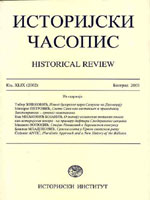О употреби појма владарске милости у српским средњовековним документима намењеним Дубровчанима
Use of the Term Royal Grace in Serbian Medieval Documents for the Citizens of Dubrovnik
Author(s): Nebojša PorčićSubject(s): History, Middle Ages
Published by: Istorijski institut, Beograd
Keywords: Serbia; Dubrovnik; Middle Ages; royal grace; Nemanjićs; regional lords; despots; treaties; quittances
Summary/Abstract: The term royal grace (milost) in Serbian medieval documents has been found to denote a ruler’s action performed to reward his faithful subjects. Although researchers have attributed its origin to Byzantine influence, the chronology and patterns of its use indicate that it was probably adopted from the Latin West. Its use to describe royal actions in favor of Dubrovnik, a political entity outside the Serbian state, resulted from close and complex relations between the two parties. First attested around 1240 in a document dealing with possession of land along the border by Dubrovnik nobles, it became firmly established in treaties regulating true “international” issues during the second half of the 13th century, when changes in mutual relations enabled Serbian rulers from the mighty Nemanjić dynasty to present themselves as hierarchically senior to the Dubrovnik commune. After that, the term was regularly used by the Nemanjićs both in treaties with the commune and in quittances settling business arrangements between the Serbian rulers and individual Dubrovnik citizens, most often in the form of the dispositive verbal phrase stvoriti milost (“to create grace”). However, among the much less powerful regional lords of the post-Nemanjić period, its use is limited to documents of the Balšić family (inconsistently) and of Prince Lazar and his successors. Rulers of the consolidated Serbian state (the Despotate), formed in the early 15th century, again applied it regularly in treaties, but not in quittances, probably due to incompatibility with the form of that document type.
Journal: Историјски часопис
- Issue Year: 2016
- Issue No: 65
- Page Range: 61-77
- Page Count: 17
- Language: Serbian

